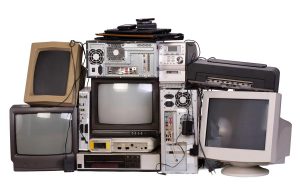
1. Remove Media from Electronic Devices
process. You don’t want to store your DVD player with a DVD inside of it or store your computer with a USB sticking out of a port.Leaving your media inside of your electronic devices may cause harm to your media. For example, a disc could get stuck inside of a DVD player
or a USB stick could get bent out of shape sticking out of your computer.
2. Remove Batteries and Ink Cartridges
Be careful with batteries and ink cartridges as well. Removing the batteries protects your electronic equipment from being damaged by a leaking battery. Batteries should not touch any metal objects while they are in storage. If possible, put the batteries back into their original packaging. If that’s not possible, make sure all the batteries are lying such that all of the positive ends line up.
Ink cartridges can also leak over time or when exposed to extreme temperatures, so be sure to remove and store ink cartridges in their own
containers as well.
3. Carefully Disconnect Wires
device.Then, use colored tape to code the wires. For example, on your television, put a green piece of tape on the power cord and on the inlet that it
plugs into. Then, put a red piece of tape on the cable cord and the cable cord inlet. Repeat this process for each cord.
Once you color-code each cord and wire, place each cord in its own small labeled ziplock bag, and then put all the smaller ziplock bags into one
large gallon-size ziplock bag that is labeled with the electronic device that the cords go to.
The more care you take with labeling and storing wires and cords, the easier it will be to set up your electronics when you take them out of
storage.
4. Use Original Packaging
repack your television for storage. The original packaging is often the best packaging to use because it was designed to protect the electronic device from damage in the shipping and selling process.When the original packaging is not available, try to find boxes that will snugly fit your electronic devices while allowing for packaging materials to be placed around your devices to keep them secure.
5. Use Lots of Packing Materials
bottom of the box, along the sides, and across the top.Use Styrofoam and packing peanuts to secure your electronic items. Or you can use soft textiles, like blankets and sheets, as packing material.
Stay away from textured fabrics that could scratch sensitive screens on your television, computer, or similar device.
6. Rent a Climate-Controlled Storage Unit
protect your electronics from extreme temperature changes.Make sure the climate-controlled storage unit allows you to control the humidity level as well. High levels of humidity can lead to corrosion and
damage to the electrical components of your electrical devices.
At Sentry Mini-Storage Inc. we can provide you with a climate-controlled storage unit that will keep your electronic items safe throughout their
time in storage. Give us a call today so we can take care of your storage needs.
